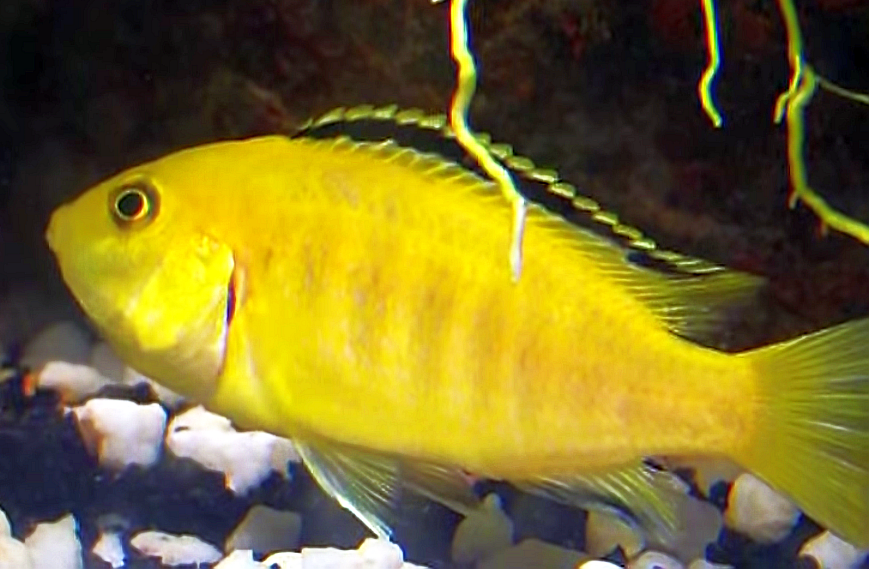The Electric Yellow Cichlid (Labidochromis caeruleus) also known by tropical fish keeping enthusiasts as the Lemon Yellow Lab, Yellow Lab , Electric Yellow Lab, Blue Streak hap., Electric Yellow or Yellow Prince. It is a naturally occurring dark cave dwelling species variant of Labidochromis caeruleus that is found at depths up to 65 feet in the central western coastal region of Nkhata Bay in Lake Malawi, East Africa.
The Electric Yellow Cichlid was originally discovered in Lion’s Cove, between the islands of Charo and Mbowe in Lake Malawi. In the 1980s, because it was first displayed and exported from Burundi, it was erroneously believed to be a Lake Tanganyikan cichlid. It is now commercially referred to as Labidochromis tanganicae.
Electric Yellow Cichlids have a striking electric yellow body color that in mature specimens is contrasted by horizontal black stripes and vertical bars.
Compared to other African Cichlids, the Electric Yellow Cichlid is shy and peaceful, however, it displays distinct social and territorial behaviors and will act aggressively towards other fish with a similar body shape or color that is perceived as a threat.
Electric Yellow Cichlids need a 55 gallon or larger tank with a sandy aggregate, hardy plants, plenty of “holey” rock (honeycomb limestone), caves, and a lot of swimming area. They can be housed with most zebra cichlid varieties including Rusty Cichlids, Yellow Tail Acei, Peacocks, Featherfins, Lamprologus, other Mbuna, and other more peaceful and less aggressive African cichlid species.
Labidochromis caeruleus live in depth of over 65 feet and prefer dark caves to forage and breed in. Adult males are usually one third larger than females and tend to have more black on their longer pelvic and anal fins. These cichlids are mouth brooders that are easily bred in an aquarium environment. Spawning occurs most often when water levels in the aquarium are lowered for a day and clean water is then added to the tank. The male will choose a spot, usually a nice flat stone, where the female will then lay her eggs. As the male fertilizes the eggs, the female will collect them into her mouth. The process is repeated a few times until 15 to 30 eggs are held in the mouth of the female. She will then hide in a cave for about 3 weeks until incubation is completed.
Younger inexperienced females usually brood around 10 fry; older ones can have up to 30. As long as the female has a good hiding place, she can be kept in the main tank during the incubation period and the fry will remain safe with their parents, even after they have been released.
Sometimes if you try to remove the female from the tank after the young are released, the stress will cause her to eat her babies. After the egg sacs are absorbed, feed the fry crushed vegetable based flake food or baby brine shrimp until they are able to fend for themselves.
In the wild, the Electric Yellow Cichlid primarily feeds on insects, snails, and small mollusks. In an aquarium environment, they will accept a wide assortment of foods, but a Spirulina based flake food or pellet that contains vegetable matter with an occasional supplement of live or frozen meaty foods such as brine shrimp and bloodworms is recommenced to prevent “Malawi Bloat” and keep them healthy.
Most Electric Yellow Cichlids available to tropical fish keeping enthusiasts today are farm bred and available in sizes from 1 1/2″-2″ small, 2″-3″ mediums, and 3″-5″ adults.
Minimum Tank Size: 55 gallons
Care Level: Easy
Temperament: Semi aggressive
Aquarium Hardiness: Moderately hardy
Water Conditions: 72-82° F, KH 10-15, pH 7.8-8.5
Max. Size: 5″
Color Form: Yellow
Diet: Omnivore
Compatibility:
Origin: Lion’s Cove, Lake Malawi, Africa
Family: Cichlidae
Lifespan: 6 – 10 years
Aquarist Experience Level: Beginner to Intermediate



